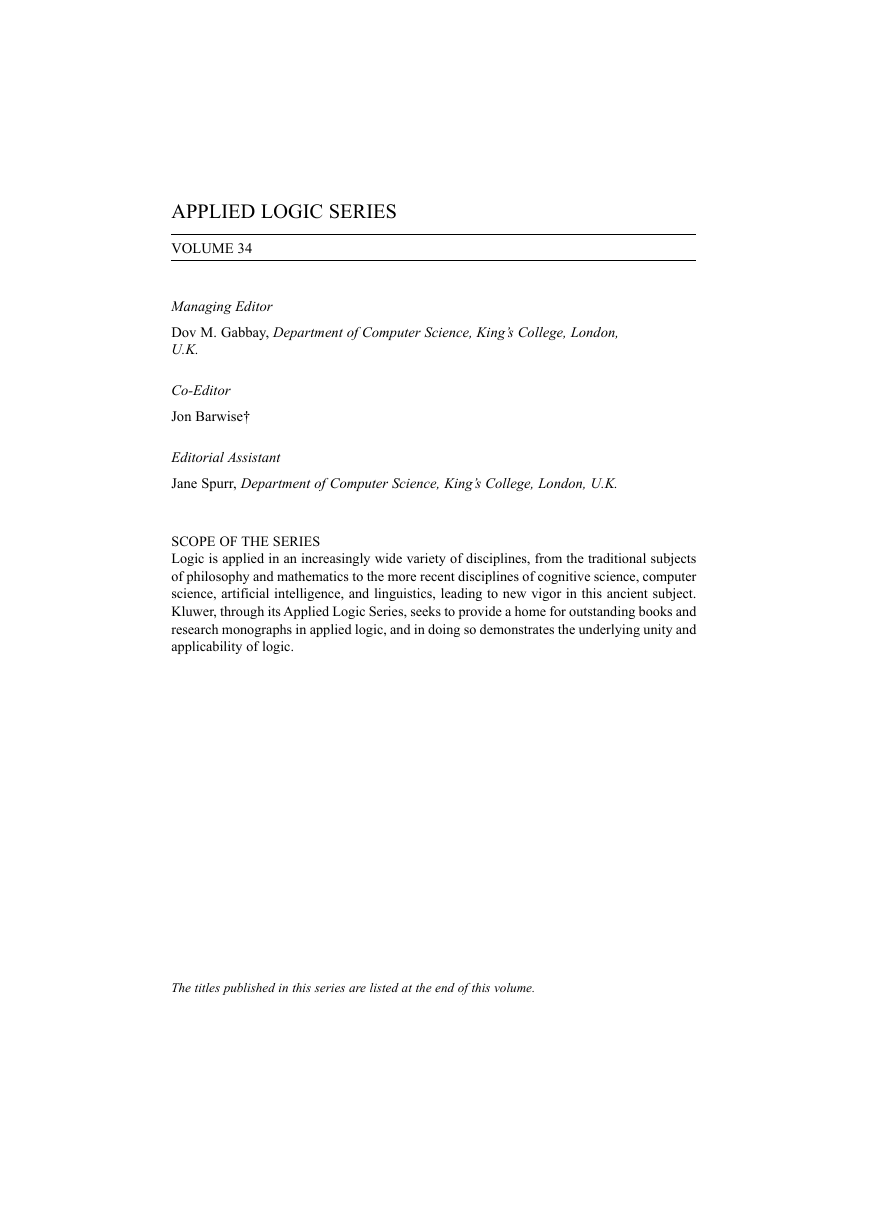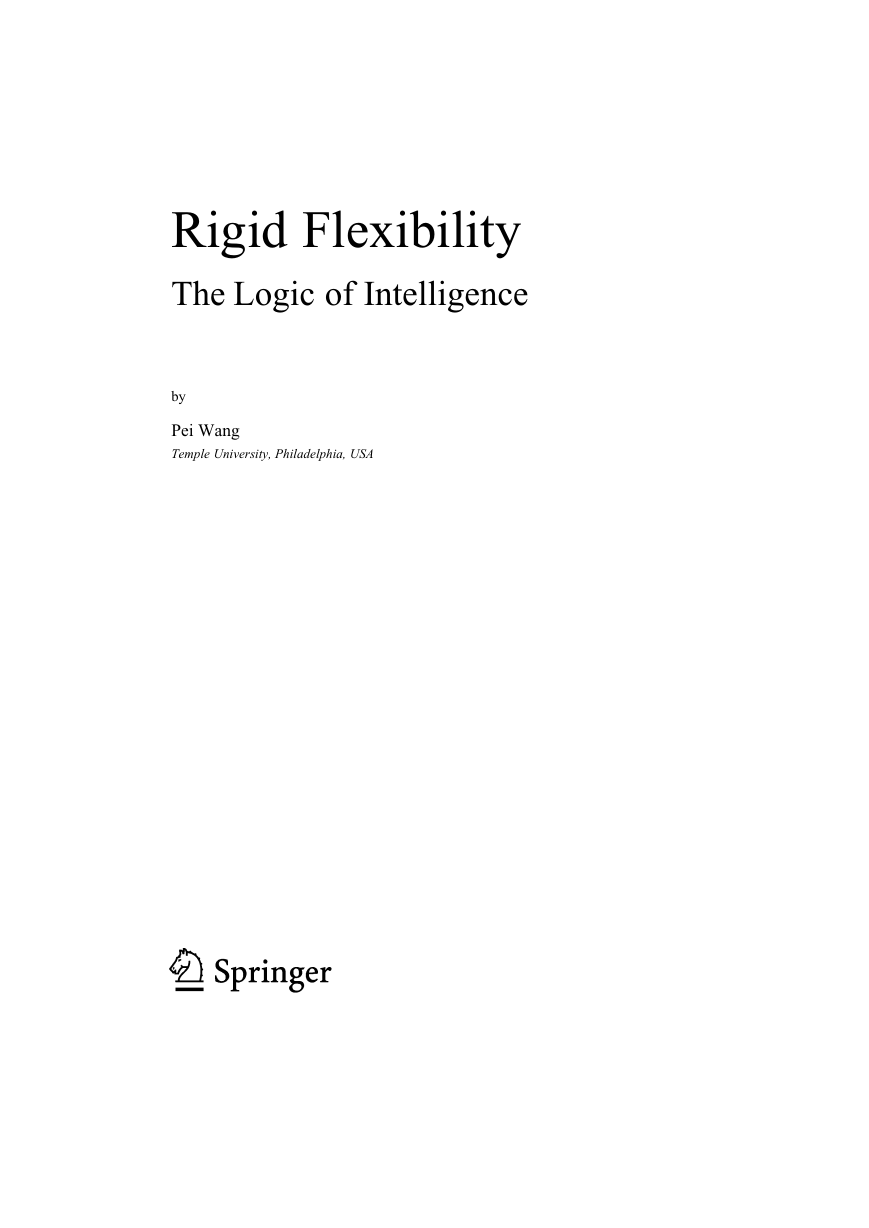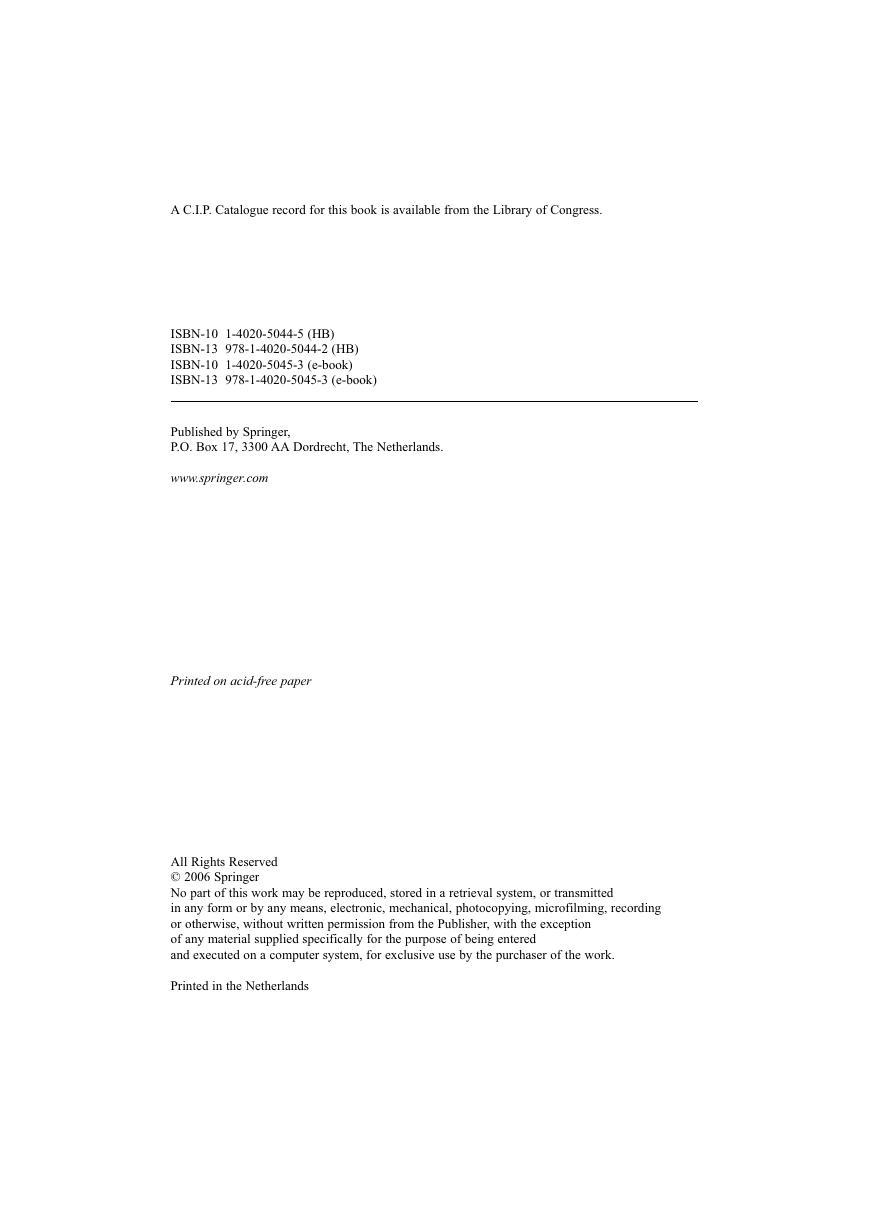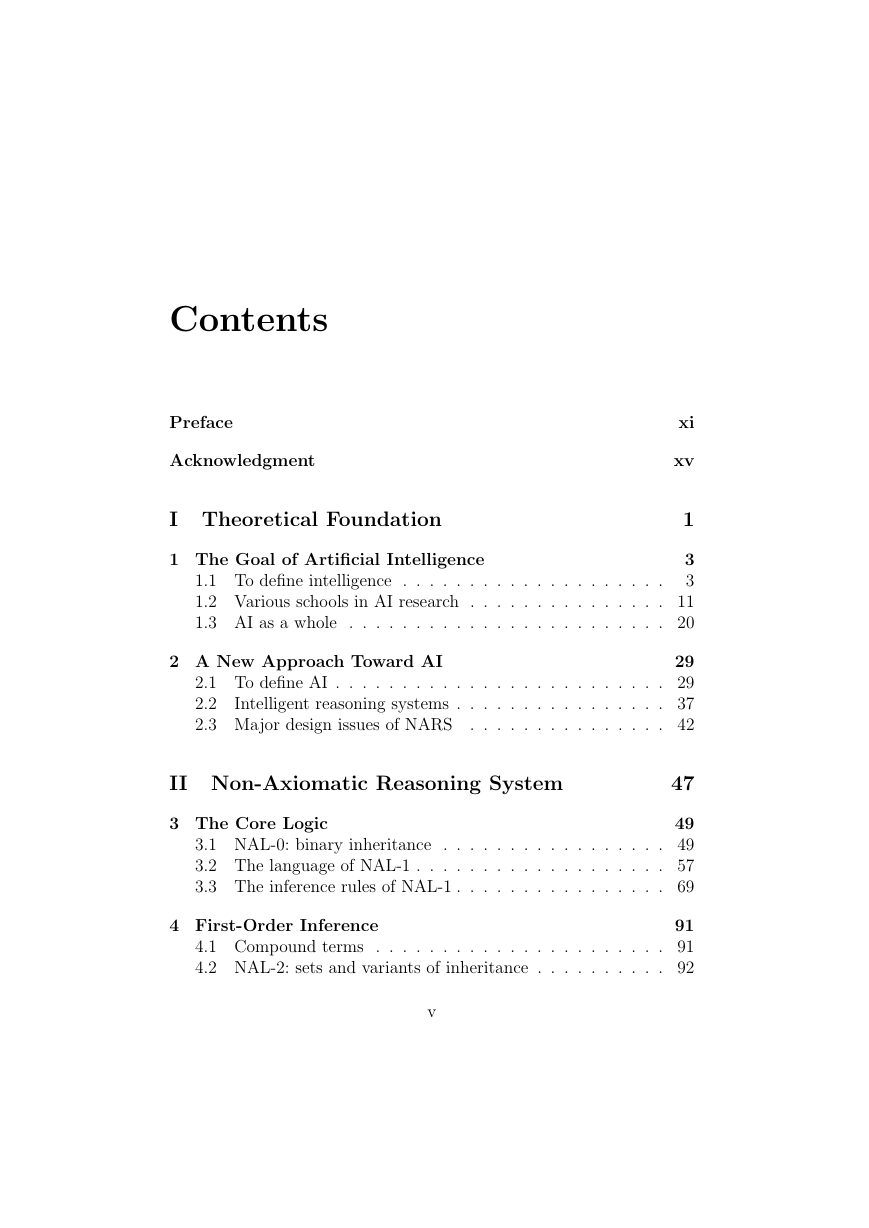A P P L I E D L O G I C S E R I E S
34
Rigid Flexibility
The Logic of Intelligence
Pei Wang
�
Rigid Flexibility
�
APPLIED LOGIC SERIES
VOLUME 34
Managing Editor
Dov M. Gabbay, Department of Computer Science, King’s College, London,
U.K.
Co-Editor
Jon Barwise†
Editorial Assistant
Jane Spurr, Department of Computer Science, King’s College, London, U.K.
SCOPE OF THE SERIES
Logic is applied in an increasingly wide variety of disciplines, from the traditional subjects
of philosophy and mathematics to the more recent disciplines of cognitive science, computer
science, artificial intelligence, and linguistics, leading to new vigor in this ancient subject.
Kluwer, through its Applied Logic Series, seeks to provide a home for outstanding books and
research monographs in applied logic, and in doing so demonstrates the underlying unity and
applicability of logic.
The titles published in this series are listed at the end of this volume.
�
Rigid Flexibility
The Logic of Intelligence
by
Pei Wang
Temple University, Philadelphia, USA
�
A C.I.P. Catalogue record for this book is available from the Library of Congress.
ISBN-10 1-4020-5044-5 (HB)
ISBN-13 978-1-4020-5044-2 (HB)
ISBN-10 1-4020-5045-3 (e-book)
ISBN-13 978-1-4020-5045-3 (e-book)
Published by Springer,
P.O. Box 17, 3300 AA Dordrecht, The Netherlands.
www.springer.com
Printed on acid-free paper
All Rights Reserved
© 2006 Springer
No part of this work may be reproduced, stored in a retrieval system, or transmitted
in any form or by any means, electronic, mechanical, photocopying, microfilming, recording
or otherwise, without written permission from the Publisher, with the exception
of any material supplied specifically for the purpose of being entered
and executed on a computer system, for exclusive use by the purchaser of the work.
Printed in the Netherlands
�
Contents
Preface
Acknowledgment
I Theoretical Foundation
xi
xv
1
1 The Goal of Artificial Intelligence
3
1.1 To define intelligence . . . . . . . . . . . . . . . . . . . .
3
1.2 Various schools in AI research . . . . . . . . . . . . . . . 11
1.3 AI as a whole . . . . . . . . . . . . . . . . . . . . . . . . 20
2 A New Approach Toward AI
29
2.1 To define AI . . . . . . . . . . . . . . . . . . . . . . . . . 29
2.2
Intelligent reasoning systems . . . . . . . . . . . . . . . . 37
2.3 Major design issues of NARS . . . . . . . . . . . . . . . 42
II Non-Axiomatic Reasoning System
47
3 The Core Logic
49
3.1 NAL-0: binary inheritance . . . . . . . . . . . . . . . . . 49
3.2 The language of NAL-1 . . . . . . . . . . . . . . . . . . . 57
3.3 The inference rules of NAL-1 . . . . . . . . . . . . . . . . 69
4 First-Order Inference
91
4.1 Compound terms . . . . . . . . . . . . . . . . . . . . . . 91
4.2 NAL-2: sets and variants of inheritance . . . . . . . . . . 92
v
�
vi
Contents
4.3 NAL-3: intersections and differences . . . . . . . . . . . . 100
4.4 NAL-4: products, images,
and ordinary relations
. . . . . . . . . . . . . . . . . . . 109
5 Higher-Order Inference
115
5.1 NAL-5: statements as terms . . . . . . . . . . . . . . . . 115
5.2 NAL-6: statements with variables . . . . . . . . . . . . . 127
5.3 NAL-7: temporal statements . . . . . . . . . . . . . . . . 134
5.4 NAL-8: procedural statements . . . . . . . . . . . . . . . 138
6 Inference Control
149
6.1 Task management . . . . . . . . . . . . . . . . . . . . . . 150
6.2 Memory structure . . . . . . . . . . . . . . . . . . . . . . 158
6.3
. . . . . . . . . . . . . . . . . . . . . 162
Inference processes
. . . . . . . . . . . . . . . . . . . . . 165
6.4 Budget assessment
III Comparison and Discussion
171
7 Semantics
173
7.1 Experience vs. model
. . . . . . . . . . . . . . . . . . . . 174
7.2 Extension and intension . . . . . . . . . . . . . . . . . . 183
7.3 Meaning of term . . . . . . . . . . . . . . . . . . . . . . 189
7.4 Truth of statement . . . . . . . . . . . . . . . . . . . . . 195
8 Uncertainty
201
8.1 The non-numerical approaches . . . . . . . . . . . . . . . 201
8.2 The fuzzy approach . . . . . . . . . . . . . . . . . . . . . 206
8.3 The Bayesian approach . . . . . . . . . . . . . . . . . . . 219
8.4 Other probabilistic approaches . . . . . . . . . . . . . . . 236
8.5 Unified representation of uncertainty . . . . . . . . . . . 241
9 Inference Rules
245
9.1 Deduction . . . . . . . . . . . . . . . . . . . . . . . . . . 245
9.2
Induction . . . . . . . . . . . . . . . . . . . . . . . . . . 253
9.3 Abduction . . . . . . . . . . . . . . . . . . . . . . . . . . 263
9.4
Implication . . . . . . . . . . . . . . . . . . . . . . . . . 265
�
Contents
vii
10 NAL as a Logic
271
10.1 NAL as a term logic
. . . . . . . . . . . . . . . . . . . . 271
10.2 NAL vs. predicate logic . . . . . . . . . . . . . . . . . . . 278
. . . . . . . . . . . . . . . . . . . . . . . . 285
10.3 Logic and AI
11 Categorization and Learning
297
11.1 Concept and categorization . . . . . . . . . . . . . . . . 297
11.2 Learning in NARS . . . . . . . . . . . . . . . . . . . . . 310
12 Control and Computation
319
12.1 NARS and theoretical computer science . . . . . . . . . . 319
12.2 Various assumptions about resources
. . . . . . . . . . . 331
12.3 Dynamic natures of NARS . . . . . . . . . . . . . . . . . 338
IV Conclusions
345
13 Current Results
347
13.1 Theoretical foundation . . . . . . . . . . . . . . . . . . . 347
13.2 Formal model
. . . . . . . . . . . . . . . . . . . . . . . . 351
13.3 Computer implementation . . . . . . . . . . . . . . . . . 354
14 NARS in the Future
357
14.1 Next steps of the project . . . . . . . . . . . . . . . . . . 357
14.2 What NARS is not . . . . . . . . . . . . . . . . . . . . . 364
. . . . . . . . . . . . . . . . . . . . 367
14.3 General implications
Bibliography
Index
371
399
�
















 2023年江西萍乡中考道德与法治真题及答案.doc
2023年江西萍乡中考道德与法治真题及答案.doc 2012年重庆南川中考生物真题及答案.doc
2012年重庆南川中考生物真题及答案.doc 2013年江西师范大学地理学综合及文艺理论基础考研真题.doc
2013年江西师范大学地理学综合及文艺理论基础考研真题.doc 2020年四川甘孜小升初语文真题及答案I卷.doc
2020年四川甘孜小升初语文真题及答案I卷.doc 2020年注册岩土工程师专业基础考试真题及答案.doc
2020年注册岩土工程师专业基础考试真题及答案.doc 2023-2024学年福建省厦门市九年级上学期数学月考试题及答案.doc
2023-2024学年福建省厦门市九年级上学期数学月考试题及答案.doc 2021-2022学年辽宁省沈阳市大东区九年级上学期语文期末试题及答案.doc
2021-2022学年辽宁省沈阳市大东区九年级上学期语文期末试题及答案.doc 2022-2023学年北京东城区初三第一学期物理期末试卷及答案.doc
2022-2023学年北京东城区初三第一学期物理期末试卷及答案.doc 2018上半年江西教师资格初中地理学科知识与教学能力真题及答案.doc
2018上半年江西教师资格初中地理学科知识与教学能力真题及答案.doc 2012年河北国家公务员申论考试真题及答案-省级.doc
2012年河北国家公务员申论考试真题及答案-省级.doc 2020-2021学年江苏省扬州市江都区邵樊片九年级上学期数学第一次质量检测试题及答案.doc
2020-2021学年江苏省扬州市江都区邵樊片九年级上学期数学第一次质量检测试题及答案.doc 2022下半年黑龙江教师资格证中学综合素质真题及答案.doc
2022下半年黑龙江教师资格证中学综合素质真题及答案.doc